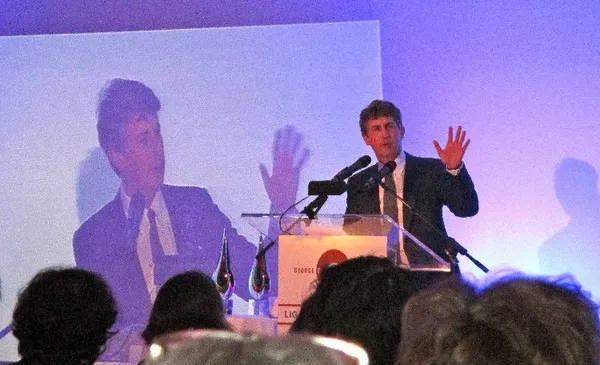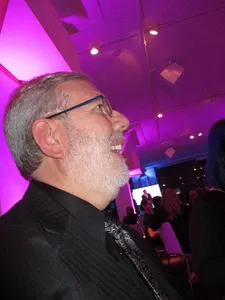 |
| Alexander Payne accepting Eastman House Lifetime Achievement in Film award: "I've been an ardent film watcher since age five." Photo: Anne-Katrin Titze |
On a beautiful spring evening in New York City, the second annual George Eastman House Light & Motion Gala celebrated preservation & restoration in Tribeca at Three Sixty°, a black and white affair. The 2014 honorees were film historian and critic Leonard Maltin, filmmakers Alexander Payne and Julia Loktev, photographers Mary Ellen Mark and Chris McCaw and self-publishing platform Blurb.
 |
| Film historian and critic, Leonard Maltin Light & Motion Award for Advocacy: "It's so vital to keep these films alive." Photo: Anne-Katrin Titze |
Paul Giamatti and Steven Soderbergh came to present awards. The honorary chairs of the Light & Motion Gala were Ken Burns, Richard Gere, and Howard Greenberg.
At the cocktail reception before the dinner and awards ceremony, I spoke briefly with Alexander Payne, Paul Giamatti and the Chair of the Board for George Eastman House, Thomas Jackson, on the importance of preservation and restoration.
Anne-Katrin Titze: Was there a specific moment when you realised that film wasn't simply there and lasting forever but needed to be preserved and restored?
Alexander Payne: No - or I don't remember…[he gave me a reason].
Payne serves on the board of directors of the Film Foundation, a nonprofit organisation dedicated to preserving motion picture history, and on the board of Film Streams, a cinematheque in Omaha.
In his acceptance speech for his Lifetime Achievement in Film award, Payne went back in time. "I've been an ardent film watcher since age five," he said, giving a special shout out to John Huston's The Treasure Of The Sierra Madre (1948), Akira Kurosawa's Seven Samurai (1954) and Billy Wilder's Sunset Boulevard (1950). "I've been reading Maltin since I was eight," he continued, "whenever I pray, I always include Leonard Maltin."
| |
| Julia Loktev with her Emerging Icon in Film award: "I always had the sense that film is something very, very fragile that needs to be taken care of." Photo: Anne-Katrin Titze |
The importance of film restoration dawns on some a little later in life.
Paul Giamatti: It's crazy delicate. No, I was stupid until recently.
"Alexander is kind of old-school," he said of his Sideways director upon presenting Payne the award. "I've never seen a director more keenly aligned to cinema's history." And that is not all, "he has great hair and is a snappy dresser," Giamatti said, which Payne proved in a beautiful blue suit that evening. "It's just so pretty," he explained to me earlier about the suit and his breach of the black and white dress code suggestion. This was not the first time we spoke about clothes. He and his Descendants star George Clooney had given me insight into the art of pants selection when their film premiered at the New York Film Festival in 2011.
Anne-Katrin Titze: Tell me about holding your Light & Motion Gala in New York City!
Thomas Jackson: One of the things Eastman House has become very cognisant of is that we have great collections, we have great people, we have amazing research being done and we're in Rochester, New York. We really need to be seen and visible in the cultural centers of the country. This is an effort to be more engaged in New York, be recognised in New York, do something for our New York friends and supporters, sort of all rolled up into one. It's part of a long-term strategy to recognise that George Eastman House really needs to take the wraps off itself and get better known. That requires us to leave Rochester and go out and be a part of the world, which is what tonight is about.
AKT: This is your second gala?
In 2013, the honorary chairs for the gala were Tina Barney, Ken Burns, Philip Kaufman and Martin Scorsese with awards going to Film Forum's Bruce Goldstein, Howard Greenberg, Ben and Joshua Safdie, Jeff Chien-Hsing Liao, Carole and Howard Tanenbaum.
 |
| Alexander Payne with Corporate Award presenter Steven Soderbergh to Blurb Photo: Anne-Katrin Titze |
TJ: This is the second gala. The first one was, I think, extraordinarily successful for our first ever event, even though we had to reschedule it. We were originally going to do it the Monday after [2012's Super Storm] Sandy. So on Saturday we cancelled it. We scheduled it for six months later and still had an amazingly good turnout. This one is, I think, one scale up. It's better attended and we have more prominent awardees. I think this is going to be an exciting evening.
Seated next to me at dinner was Leonard Maltin, accompanied by his daughter Jessica. He took the honoring in stride and we chatted about The Whistler and Richard Dix. Maltin was awarded the 2014 Light & Motion Award for Advocacy and praised Eastman House for its "essential, vital work."
Julia Loktev, seated on my other side at the table, was awarded the Emerging Icon in Film award. She spoke about the nature of film as an "ephemeral medium," and pointed out that "today, we live in this illusion of plenty."
Before the ceremony began I spoke to both winners at my table.
Anne-Katrin Titze: When did you first become aware of the importance of film preservation and restoration?
Leonard Maltin: When I was very young. That's a good question.
Maltin currently votes on the National Film Registry and sits on the Board of Directors of the National Film Preservation Foundation.
 |
| Paul Giamatti honoring Alexander Payne: "I've never seen a director more keenly aligned to cinema's history." Photo: Anne-Katrin Titze |
AKT: I think it is an important moment when you realise that a film doesn't just exist and stay there forever.
LM: I know. Some years ago, I interviewed George Lucas and he told me that when it came time to reissue the first Star Wars, he was appalled by the original negative. It was falling apart, the splices were starting to separate. When you hear things like that, it's very sobering. I have to say, it has been a gradual learning experience. When the Library of Congress vaults were still in Dayton, Ohio before they moved to their current location in Culpeper, Virginia, I got to hold in my hand the original camera negative of Thomas Edison's The Great Train Robbery. In perfect condition. From 1903. Then they showed me films from the 1940s that were deteriorating. It's sobering and kind of a needed wake-up call every time.
AKT: It has an interesting effect on you when a film that could only be seen as a scratched-up VHS copy is suddenly on the screen in pristine condition. I spoke with Kent Jones about Arthur Ripley's The Chase at last year's New York Film Festival. It made me feel as though I were watching Michèle Morgan in 1946.
LM: It's so vital to keep these films alive. They have to have a continuing life, which is to say being shown to audiences, being discovered by new generations. And that can only happen if they exist in the condition we expect them to be in. You're not going to attract anyone with a crummy VHS tape.
Previously, I had a conversation with Julia Loktev about her film The Loneliest Planet and we last ran into each other at a screening of Wim Wenders' Pina at BAMcinématek in Brooklyn. At the gala we shared some party talk - on life and death and celluloid.
 |
| Chair of the Board of George Eastman House, Thomas Jackson: "I think this is going to be an exciting evening." Photo: Anne-Katrin Titze |
Julia Loktev: Every time you watch a film you're watching the film's disintegration in a sense. People grow up now watching Blu-rays and they have the perfect image. We grew up watching movies and every time you watched it, you're seeing the scratches, you're seeing erasure, you're seeing the film's own death in a sense. I think from the start, I always had the sense that film is something very, very fragile that needs to be taken care of.
AKT: You are making a good point about a generational difference in how films are seen and the possible emotional impact. Now every repeat viewing is the same.
JL: You don't see the scratches accumulating with every print that I've seen growing up. I saw the scratches and I saw the dust and the dust bunnies crawling across the screen - all the imperfections. It's almost like a vinyl record - you were killing it every time you were playing it, in a way.
AKT: Which brings it closer to life. We die from the moment we are born.
JL: Exactly. As my knees keep telling me. The process of time is inherently degenerate. When you grow up watching celluloid you are aware of that. You don't have that sense that it could ever be picture-perfect.
George Eastman House holds unparalleled collections, totaling more than four million objects, of photographs, motion pictures, cameras and technology, and photographically illustrated books. Established as an independent nonprofit institution in 1947, it is the world’s oldest photography museum and third largest film archive in the United States. The museum is in Rochester, New York, and includes the National Historic Landmark house and gardens of George Eastman, the philanthropist and father of popular photography and motion picture film.
“As a filmmaker, I appreciate having the support of such a passionate and talented team at George Eastman House to help bring my vision for a film full circle,” said Ken Burns, who has a collection preserved in the vaults at the museum. “Preserving a film’s story, message, images and emotion allows the art to stand the test of time, keeping it accessible and relevant for years to come.”
We had a ball celebrating film preservation and photograph conservation, while Anna Wintour's Metropolitan Museum Costume Institute Gala celebrated the Charles James exhibition in white tie across town.
 |
| George Eastman House 2014 Light & Motion Gala celebrating preservation & restoration. |





















